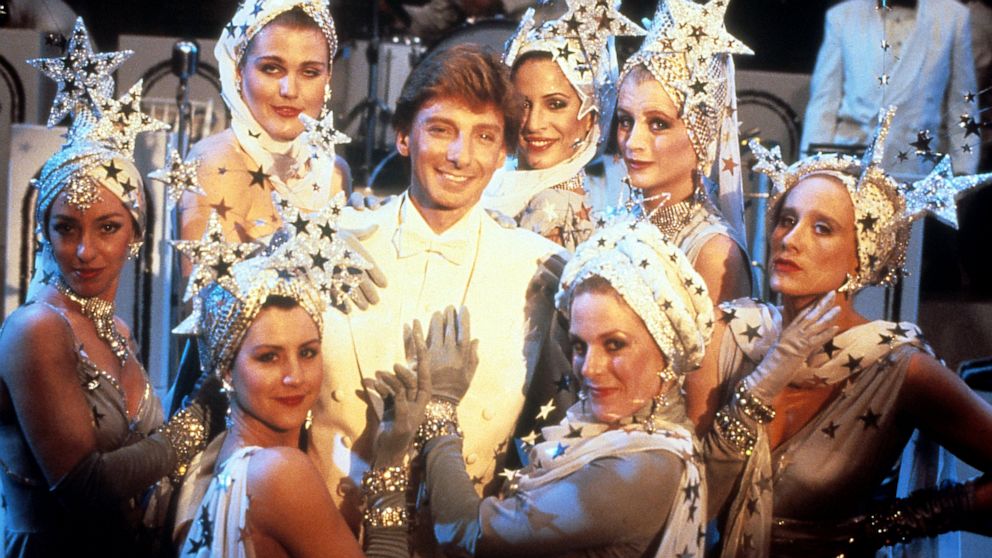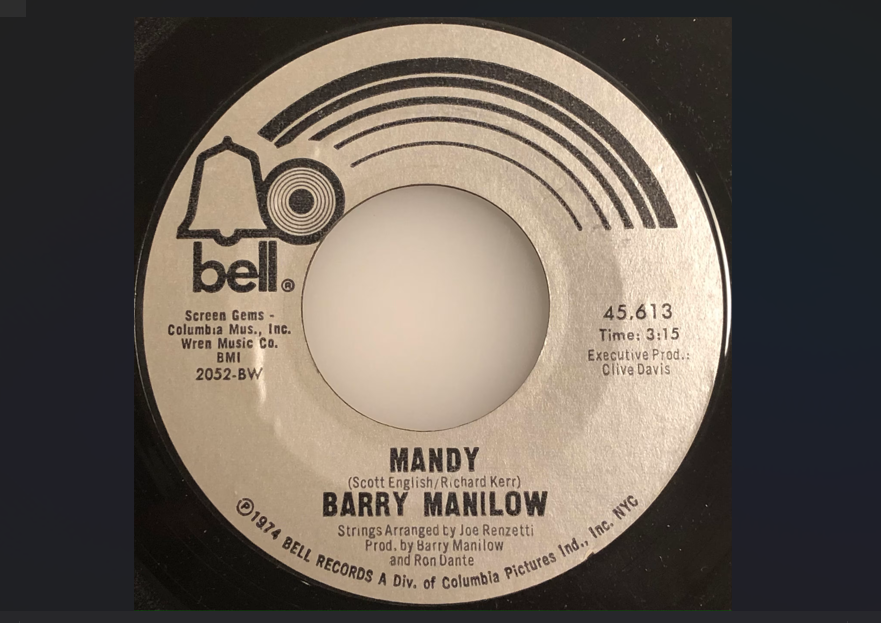
Two major benchmarks for Barry Manilow (b.1943) passed last year: the singer/musician/songwriter/producer turned 80 years old; and his self-titled debut LP turned 50.
This year marks another 50th, as well: that of his first hit single, “Mandy”, released in 1974, which went all the way to #1 on the pop charts. I acquired that single at a yard sale as a tween and played the hell out of it. The melancholy melodrama, the over-the-top sweep of it appealed to my kid-heart. The song is all about regret. As a pre-teen I was way too young for regrets, but then as now, I was all about emotions, whether real or imagined, and I hadn’t yet developed the sourpuss internal gatekeeper all critics manufacture for themselves. That part of me emerged surprisingly early. I was honestly only about 13 years old when I began…rejecting things. Deciding this or that was “too much” or tasteless or, worst of all, corny. As a teenager I closed doors that had been open to me as a kid. It has been something like a solace to me a half century later to coax that part of me back, because there’s something genuine and honest and meaningful about it and if a critic, or any kind of writer, loses the connection to that purity, he’s lost as both a craftsman and a person.
Returning means you’ve turned away, though, and I did. A lot of people did. I was a teenage boy. I liked drums and electric guitars and screaming, of course! Alice Cooper and Kiss and The Who also sang ballads, but that wasn’t ALL they did. They weren’t identified with it. There was a squareness to Barry Manilow. He sat there at those shiny grand pianos in bow-ties and tails like a next generation Liberace but without the garish visual camp you got from Elton John. I liked plenty of his songs, but the record machine shoved them down your throat until you wanted to puke. He also suffered (in my eyes), as many did, by being one of those artists corralled into the despised “Easy Listening” radio format. I’ve since realized that I like and respect plenty of those artists — it’s just that filling an entire listening program with them is like being locked in the cafeteria of a very treacly retirement home. If you’re young you want to wriggle out of it, escape, and go run around outside. I’m almost 60 and I still feel the same way.
It’s easier to be objective now about Manilow’s prodigious talent and massive productivity. It deserves enormous respect, whatever his past as a punchline. I can no longer justify naming this post, “The Many Lows of Manilow”, as I once might have.
The Jewish-Irish Williamsburg, Brooklyn native studied at the New York College of Music and Julliard. His day job was at CBS, where he met director Bro Herrod, who hired him to write the music for a version of the old melodrama classic The Drunkard which played at the 13th Street Rep from 1964 to 1972. Thus, he has downtown street cred! He also wrote and performed jingles for television commercials, the most famous of which is surely “And like a good neighbor, State Farm is there!” For a time (around 1969) he was in a group with Tony Orlando called Featherbed.
The turning point came in 1971 when Bette Midler hired Manilow to be her accompanist and musical director for her long-term residency at the Continental Baths, leading to his producing her seminal albums The Divine Miss M (1972) and Bette Midler (1973). A fan of the Andrews Sisters, he thus had a hand in her 1973 hit cover of “Boogie Woogie Bugle Boy”.
After “Mandy” went to #1, Manilow came into his own. His breakthrough hit was followed by the chipper “It’s a Miracle” (1975, #12) and the romantic “Could It Be Magic” (1975, #6), the tune of which was based on a Chopin composition. His second #1, the plodding “I Write the Songs” (1975), penned by second-string Beach Boy Bruce Johnston has always been my least favorite of his hits — like fingernails on a chalkboard to me. When the song was popular it sounded to me like egotism. (Arms folded): “So you’re music, are ya?” Later when I learned that the singer was actually supposed to be the spirit of music itself, personified, I liked it even less. Blecch!
Then came “Tryin’ to Get The Feeling Again” (1976, #10), “Weekend in New England” (1976, #10), “Looks Like We Made It” (1976, #1), and “Daybreak” (1976, #23). In 1977 Manilow teamed up with Dick Clark in two important ways, recording a new version of the American Bandstand theme that was used on the show for most of the next decade, as well as the tune “It’s Just Another New Year’s Eve”, which he performed on Dick Clark’s Rockin’ New Year’s Eve annually for several years. Manilow was starting to become something like an institution at this point. He starred in several of his own TV variety specials. And released more hit singles, such as the monotonous, cruelly relentless “Can’t Smile Without You” (1978, #3).
And OF COURSE the hokey, Vegassy, but kind of brilliant “Copacabana” (1978, #8). This has probably come to be Manilow’s most ridiculed song, but come on, the guy was a showman, and I happen to think it’s pretty excellent. It’s what, above all, inspired this post’s eventual title, with its imagery of the famous nightclub, the gangsters and show girls. It brings your head to a specific place, like a bit of radio theatre, and it kind of expressed the zeitgeist, whether one liked it or not. That year he also recorded the theme song to the movie Foul Play with Chevy Chase and Goldie Hawn, the exhilarating “Ready to Take a Chance Again” (#11), which might be my favorite of all his songs. I’m also fond of the uplifting “I Made It Through the Rain” (1980, #10).
Manilow continued to have hits into the early ’80s, though most of the later ones were less memorable, maybe because they were less flogged to death on AM radio. By the way, his co-producer on most of his records, was Ron Dante, the guy who sang lead for The Archies! Other cool people Manilow worked with included (shockingly) Ian Hunter of Mott the Hoople who penned his #9 1979 hit “Ships”, and Kid Creole and the Cocoanuts, with whom he recorded the 1988 single “Hey Mambo”. A couple of Manilow’s LPs from the period when he drifted out of the top 40 (2:00 AM Paradise Cafe, 1984, and Swing Street, 1987) demonstrated a lot of artistic integrity, a lot of taste and willingness to take risks. What did he need more hit singles for? Many or most of his subsequent records over the past several decades explored jazz and Tin Pan Alley rather then attempting to mirror current pop trends. He also branched in new directions by penning a 1987 memoir and starring in a 1985 TV movie based on Copacabana. Unfortunately, much like Hoagy Carmichael, Manilow has always had a better face for radio. (I think he’s had some work done. At the risk of going the way of Roseanne, in recent times his appearance evokes nothing so much as this.)
Manilow also wrote the music for the 1994 animated film Thumbelina which starred The Little Mermaid’s Jodi Benson, and also featured the voices of Barbara Cook, Carol Channing, Gilbert Gottfried, Charo, and John Hurt. This was followed by The Pebble and the Penguin (1995) with Martin Short, Jim Belushi, Tim Curry and Annie Golden.
In 2017, Manilow came out as gay, a formality really, for it had been a fairly open secret for just about the entirety of his career. By then even his little old lady fanbase were okay with that, but still, every little bit helps. They gave him a big tribute at Carnegie Hall a few months ago, and he’s playing Radio City Music Hall in a few months. I have no desire to attend, but I’m glad it’s happening.
For more on show biz history, consult No Applause, Just Throw Money: The Book That Made Vaudeville Famous, And please stay tuned for my upcoming Electric Vaudeville: A Century of Radio and TV Variety.


You must be logged in to post a comment.